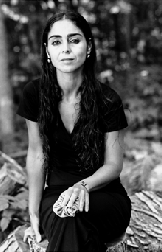 Shirin Neshat
Shirin Neshat Shirin Neshat
Shirin Neshat
Nell'occasione della personale di
Shirin Neshat al Castello di Rivoli - Museo d'Arte
Contemporanea dal 30
gennaio al 5 maggio 2002, dedichiamo una pagina introduttiva
all'artista.
Nata a Qazvin nel 1957, Shirin Neshat ha lasciato l'Iran nel 1974
per gli Stati Uniti, dove ha studiato arte ed ha cominciato ad
affermarsi come fotografa, filmmaker e videoartista.
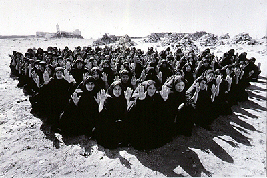 La sua esperienza personale tra due
culture e la riflessione sul regime di vita imposto dagli
Ayatollah, che l'artista ha verificato di persona al suo primo
rientro in Iran nel 1990 alla morte di Khomeini, sono divenuti i
riferimenti costanti della sua produzione artistica.
La sua esperienza personale tra due
culture e la riflessione sul regime di vita imposto dagli
Ayatollah, che l'artista ha verificato di persona al suo primo
rientro in Iran nel 1990 alla morte di Khomeini, sono divenuti i
riferimenti costanti della sua produzione artistica.
Il modo differente in cui culture islamiche e culture
'occidentali' trattano temi quali la vita e la morte, la
ciclicità dell'esistenza, il rapporto tra i sessi, la libertà e
la censura, diventano materiale per operare un confronto
interessato a mettere in luce pregiudizi e punti di vista,
lasciando gli interlocutori e gli spettatori liberi di operare le
proprie interpretazioni.
Le video-installazioni e le fotografie esposte in questa mostra
sono state scelte dall'artista tra la sua produzione più
recente.
Rapture (1999) è letterariamente e
figurativamente una separazione di genere. L'installazione
consiste in due ampie, opposte proiezioni che mostrano uomini e
donne separati gli uni dalle altre. La donne, coperte dal chador,
si muovono liberamente nello spazio esterno. L'opera vuole
evidenziare l'assurdità di certi atteggiamenti maschili e
rovescia ruoli stereotipici associati con il genere.
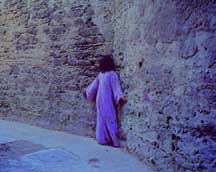 Gli altri video presentati nella mostra
riflettono anch'essi sulla condizione della donna islamica sia
quando sola in casa canta una canzone d'amore seguendo il suono
di una radio, come in Pulse (Pulsazione, 2001),
sia quando vaga in preda al delirio nella piazza di una città
orientale come in Possessed (Posseduta, 2001),
affascinando e inquietando al tempo stesso la gente che la
circonda.
Gli altri video presentati nella mostra
riflettono anch'essi sulla condizione della donna islamica sia
quando sola in casa canta una canzone d'amore seguendo il suono
di una radio, come in Pulse (Pulsazione, 2001),
sia quando vaga in preda al delirio nella piazza di una città
orientale come in Possessed (Posseduta, 2001),
affascinando e inquietando al tempo stesso la gente che la
circonda.
Infine Passage (Passaggio, 2001) analizza i
grandi interrogativi dell'esistenza umana e la colonna sonora,
firmata da Philip Glass, accentua la già intensa dimensione
drammatica del visivo proposto da Shirin Neshat.
Alcune delle fotografie dell'artista (apparse in italiano nel
volume "Donne di Allah" Marco Noire Editore, Torino,
1997), si trovano in rete alla pagina The Gun and the Gaze nel virtuale Museum of Contemporary Iranian Artists.
In Italia, Shirin Neshat è stata premiata alla Biennale di Venezia, mentre all'estero sono già state
dedicate all'artista importanti personali all'Art Institute di
Chicago, al Whitney Museum di New York, alla Tate
Gallery di Londra.
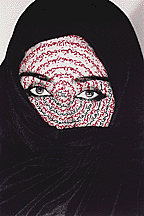 The Museum of Contemporary Art in Rivoli is giving an exhibition, from January 30
to May 5 2002, of the works by Shirin Neshat. Here follow some
introductive infos about the Iranian artist.
The Museum of Contemporary Art in Rivoli is giving an exhibition, from January 30
to May 5 2002, of the works by Shirin Neshat. Here follow some
introductive infos about the Iranian artist.
Shirin Neshat was born in Qazvin in 1957; she left Iran in 1974
to reach the United States, where she studied arts and gave her
first exhibitions of films, videos and pictures.
Her personal experience between two cultures and the reflection
upon the Ayatollah regime, that she could verify as she came back
for the first time in Iran in 1990 after Khomeini's death, became
the constant interest of her artistic production.
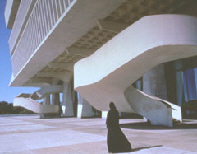 The different ways islamic cultures and
'western' cultures treat some themes such as life and death,
relationships between women and men, freedom and censorship
became tools to investigate and discuss points of view,
prejudgments, leaving interlocutors and viewers develop their own
interpretation.
The different ways islamic cultures and
'western' cultures treat some themes such as life and death,
relationships between women and men, freedom and censorship
became tools to investigate and discuss points of view,
prejudgments, leaving interlocutors and viewers develop their own
interpretation.
The exhibition includes a selection by the artist's recent
video-installations and photographs.
Rapture (1999) is literally and figuratively a
separation of genders. Neshat's video installation consists of
two large, opposing projections that depict men and women
separated from each other. Women covered by chadors move
freely in an outdoor area. This work suggests the absurdity
inherent in certain typically male behavior and reverses
stereotypical, gendered roles.
The following video installations reflect upon the condition of
islamic woman, both when she lays lonely in her bedroom,
listening and singing to a melancholic song played on the radio,
as in Pulse ( 2001) and when she wanders prey of
delirium, in the square of an Eastern city, as in Possessed
(2001), bewitching and disconcerting people who surrounds her.
 The last work, Passage
(2001) takes into account the huge problems of human existance
and the soundtrack, by Philip Glass, accentuates the intense
drama of the visual proposed by Shirin Neshat.
The last work, Passage
(2001) takes into account the huge problems of human existance
and the soundtrack, by Philip Glass, accentuates the intense
drama of the visual proposed by Shirin Neshat.
Some of her photographs can be also seen on the net in the
dedicated page The Gun and the Gaze at the virtual Museum of Contemporary Iranian Artists.
Shirin Neshat has been awarded at the Venice Biennal; her works have been exposed at the Art Institute
of Chicago, at the Whitney Museum in New York, at Tate
Gallery in London.